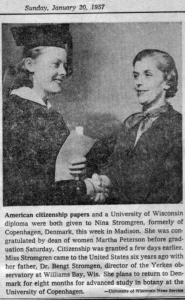There is something romantic about a scientific paper whose references count ones from the 1950s. I imagine a large industrial empire growing in the United States, hinging largely on its government funding basic research, maintaining military and defense research, and racing to the moon. The Eisenhower era marked a point in human history where Russia and the United States vyed for the top spot as the world’s technological leader. Competition possibly brought out the best in physics research of the decade. Certainly, questions brought up then have underscored much of the research going on today.
A Nature Communications paper from this past April cited a couple academic articles from the ’50s:
Morrison, P. Approximate nature of physical symmetries. Am. J. Phys. 26, 358–368 (1958).
and
Schiff, L. I. Sign of the gravitational mass of a positron. Phys. Rev. Lett. 1, 254–255 (1958).
The Morrison paper tried to prove that antimatter and matter would have the same mass, using a thermodynamics proof to codify the argument. The Schiff paper argued the same thing. Both papers were highly theoretical and provided no direct experimental proof that neither gravitational nor inertial mass differed between matter and antimatter. All of the arguments were theoretical but carry a lot of weight today. Following a logical argument with mathematics is as important to scientific research as seeing the evidence of the proof with our own eyes. The theoretical arguments of these 1958 papers have stood the test of time.
The recent experiment described in the paper was the first of its kind – ever- to directly observe the behavior of antimatter under the force of gravity. As is the case with many Nature Communications papers, no solid conclusion on the underlying question was made, but the method to experimentally poke around the subject was worth noting. The jury is still out on whether the masses of the two kinds of physical entities are not different, but we’ll get there as the Berkeley-CERN team perfect their set-up.
Rebecca Boyle of PopSci covered the experiment pretty well on May 1st, the day after it was published, but not without a little help from the press release.
Amole C., Ashkezari M.D., Baquero-Ruiz M., Bertsche W., Butler E., Capra A., Cesar C.L., Charlton M., Eriksson S. & Fajans J. & (2013). Description and first application of a new technique to measure the gravitational mass of antihydrogen, Nature Communications, 4 1785. DOI: 10.1038/ncomms2787
